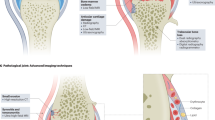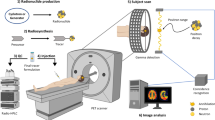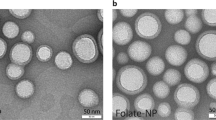Abstract
In the K/BxN mouse model of rheumatoid arthritis, the transfer of autoantibodies specific for glucose-6-phosphate isomerase (GPI) into naïve mice rapidly induces joint-specific inflammation similar to that seen in human rheumatoid arthritis. The ubiquitous expression of GPI and the systemic circulation of anti-GPI immunoglobulin G (IgG) seem incongruous with the tissue specificity of this disease. By using PET (positron emission tomography), we show here that purified anti-GPI IgG localizes specifically to distal joints in the front and rear limbs within minutes of intravenous injection, reaches saturation by 20 min and remains localized for at least 24 h. In contrast, control IgG does not localize to joints or cause inflammation. The rapid kinetics of anti-GPI IgG joint localization supports a model in which autoantibodies bind directly to pre-existing extracellular GPI in normal healthy mouse joints.
This is a preview of subscription content, access via your institution
Access options
Subscribe to this journal
Receive 12 print issues and online access
$209.00 per year
only $17.42 per issue
Buy this article
- Purchase on Springer Link
- Instant access to full article PDF
Prices may be subject to local taxes which are calculated during checkout





Similar content being viewed by others
References
Kouskoff, V. et al. Organ-specific disease provoked by systemic autoimmunity. Cell 87, 811–822 (1996).
Korganow, A.-S. et al. From systemic T cell self-reactivity to organ-specific autoimmune disease via immunoglobulins. Immunity 10, 451–461 (1999).
Ji, H. et al. Genetic influences on the end-stage effector phase of arthritis. J. Exp. Med. 194, 321–330 (2001).
Basu, D., Horvath, S., Matsumoto, I., Fremont, D. H. & Allen, P. M. Molecular basis for recognition of an arthritic peptide and a foreign epitope on distinct MHC molecules by a single TCR. J. Immunol. 164, 5788–5796 (2000).
Matsumoto, I., Staub, A., Benoist, C. & Mathis, D. Arthritis provoked by linked T and B cell recognition of a glycolytic enzyme. Science 286, 1732–1735 (1999).
Zimmerman, H. J., Schwartz, M. A., Boley, L. E. & West, M. Comparative serum enzymology. J. Lab. Clin. Med. 66, 961–972 (1965).
Chaput, M. et al. The neurotrophic factor neuroleukin is 90% homologous with phosphohexose isomerase. Nature 332, 454–455 (1988).
Faik, P., Walker, J. I., Redmill, A. A. & Morgan, M. J. Mouse glucose-6-phosphate isomerase and neuroleukin have identical 3′ sequences. Nature 332, 455–457 (1988).
Gurney, M. E., Heinrich, S. P., Lee, M. R. & Yin, H.-S. Molecular cloning and expression of neuroleukin, a neurotrophic factor for spinal and sensory neurons. Science 234, 566–574 (1986).
Watanabe, H., Takehana, K., Date, M., Shinozaki, T. & Raz, A. Tumor cell autocrine motility factor is the neuroleukin/phosphohexose isomerase polypeptide. Cancer Res. 56, 2960–2963 (1996).
Xu, W., Seiter, K., Feldman, E., Ahmed, T. & Chiao, J. W. The differentiation and maturation mediator for human myeloid leukemia cells shares homology with neuroleukin or phosphoglucose isomerase. Blood 87, 4502–4506 (1996).
Niinaka, Y., Paku, S., Haga, A., Watanabe, H. & Raz, A. Expression and secretion of neuroleukin/phosphohexose isomerase/maturation factor as autocrine motility factor by tumor cells. Cancer Res. 58, 2667–2674 (1998).
Schaller, M., Burton, D. R. & Ditzel, H. J. Autoantibodies to GPI in rheumatoid arthritis: linkage between an animal model and human disease. Nature Immunol. 2, 746–753 (2001).
Phelps, M. E. PET: the merging of biology and imaging into molecular imaging. J. Nucl. Med. 41, 661–681 (2000).
McCarthy, D. W. et al. Efficient production of high specific activity 64Cu using a biomedical cyclotron. Nucl. Med. Biol. 24, 35–43 (1997).
Lewis, M. R., Kao, J. Y., Anderson, A. L., Shively, J. E. & Raubitschek, A. An improved method for conjugating monoclonal antibodies with N-hydroxysulfosuccinimidyl DOTA. Bioconj. Chem. 12, 320–324 (2001).
Sodoyez-Goffaux, F. et al. Scintigraphic distribution of complexes of antiinsulin antibodies and 123I-insulin. In vivo studies in rats. J. Clin. Invest. 80, 466–474 (1987).
Rubin, R. H. & Fischman, A. J. The use of radiolabeled nonspecific immunoglobulin in the detection of focal inflammation. Semin. Nucl. Med. 24, 169–179 (1994).
Matsumoto, I. et al. How antibodies to a ubiquitous cytoplasmic enzyme may provoke joint-specific autoimmune disease. Nature Immunol. 3, 362–367 (2002).
Loutis, N., Bruckner, P. & Pataki, A. Induction of erosive arthritis in mice after passive transfer of anti-type II collagen antibodies. Agents Actions 25, 352–359 (1988).
Stuart, J. M., Cremer, M. A., Townes, A. S. & Kang, A. H. Type II collagen-induced arthritis in rats. Passive transfer with serum and evidence that IgG anticollagen antibodies can cause arthritis. J. Exp. Med. 155, 1–16 (1982).
Trentham, D. E., Townes, A. S. & Kang, A. H. Autoimmunity to type II collagen: An experimental model of arthritis. J. Exp. Med. 146, 857–868 (1977).
Watson, W. C., Brown, P. S., Pitcock, J. A. & Townes, A. S. Passive transfer studies with type II collagen antibody in B10.D2/old and new line and C57Bl/6 normal and beige (Chediak-Higashi) strains: evidence of important roles for C5 and multiple inflammatory cell types in the development of erosive arthritis. Arthritis Rheum. 30, 460–465 (1987).
Wooley, P. H., Luthra, H. S., Stuart, J. M. & David, C. S. Type II collagen-induced arthritis in mice. I. Major histocompatibility complex (I region) linkage and antibody correlates. J. Exp. Med. 154, 688–700 (1981).
Kerwar, S. S., Gordon, S., McReynolds, R. A. & Oronsky, A. L. Passive transfer of arthritis by purified anticollagen immunoglobulin: localization of 125I-labeled antibody. Clin. Immunol. Immunopathol. 29, 318–321 (1983).
Watanabe, H. et al. Purification of human tumor cell autocrine motility factor and molecular cloning of its receptor. J. Biol. Chem. 266, 13442–13448 (1991).
Leclerc, N., Vallee, A. & Nabi, I. R. Expression of the AMF/neuroleukin receptor in developing and adult brain cerebellum. J. Neurosci. Res. 60, 602–612 (2000).
Hollister, J. R., Liang, G. C. & Mannik, M. Immunologically induced acute synovitis in rabbits. Studies of immune complexes in synovial fluid. Arthritis Rheum. 16, 10–20 (1973).
Breedveld, F. C. et al. Imaging of inflammatory arthritis with technetium-99m-labeled IgG. J. Nucl. Med. 30, 2017–2021 (1989).
Juweid, M., Strauss, H. W., Yaoita, H., Rubin, R. H. & Fischman, A. J. Accumulation of immunoglobulin G at focal sites of inflammation. Eur. J. Nucl. Med. 19, 159–165 (1992).
Wipke, B. T. & Allen, P. M. Essential role of neutrophils in the initiation and progression of a murine model of rheumatoid arthritis. J. Immunol. 167, 1601–1608 (2001).
Lewis, M. R., Raubitschek, A. & Shively, J. E. A facile, water-soluble method for modification of proteins with DOTA. Use of elevated temperature and optimized pH to achieve high specific activity and high chelate stability in radiolabeled immunoconjugates. Bioconj. Chem. 5, 565–576 (1994).
Cherry, S. R. et al. Micropet—A high resolution pet scanner for imaging small animals. IEEE Trans. Nucl. Sci. 44, 1161–1166 (1997).
Acknowledgements
We thank T. Sharp, J. Engelbach, L. Jones and N. Mercer for assistance with animal handling in microPET and biodistribution studies; M. Welch and D. Reichert for support; R. Laforest for help in data analysis and software engineering; D. Kreamalmeyer for serum banking and managing the mouse colony; E. Unanue and H. W. Virgin IV for reading the manuscript; L. Mandik-Nayak, E. Hailman, L. Norian and F. Shih for comments and discussion; and J. Smith for administrative assistance. This work was supported by the NIH (WU Small Animal Imaging Resource R24CA083060, WU Research Resource In Radionuclide Research R24CA086307 and P01AI31238).
Author information
Authors and Affiliations
Corresponding author
Ethics declarations
Competing interests
The authors declare no competing financial interests.
Supplementary information
Web Movie 1.
One hour after injection of 250 µg of radiolabeled anti-GPI IgG, the antibody localized to the distal joints of front and rear limbs, specifically the front wrist and paw joints and rear ankle and foot joints. In contrast, much less anti-GPI IgG localized to the knee joints, and no localization was visible in the vertebrae, hip or shoulder joints or in the kidneys. Twenty-four hours after injection of radiolabeled anti-GPI IgG, it remained localized in the distal joints (front limbs, hind ankles and feet). The front and rear limbs of this mouse were visibly inflamed at 24 h (data not shown). The region corresponding to the animal's left elbow exhibited accumulation at 24 h, which was barely visible at 1 h. Small pockets of accumulation are present in regions corresponding to the location of popliteal lymph nodes. Fig. 1c panels were taken from this movie. (MOV 2046 kb)
Web Movie 2.
One hour after injection of 250 µg of radiolabeled normal IgG, no localization in joints was observed and the majority of antibody remained in the blood pool, heart and liver. No detectable signal was present in the kidneys. Twenty-four hours after injection of radiolabeled normal IgG, there was no localization in the distal joints. Faint outlines of the front and rear limbs were visible, consistent with low-level nonspecific tissue absorption of normal IgG. No measurable or visible inflammation was noted. The strongest signals are contained within the blood pool, heart, liver and spleen. Fig. 1d panels were taken from this movie. (MOV 2202 kb)
Web Movie 3.
Timecourse of anti-GPI IgG accumulation in distal joints from 0-30 min dynamically imaged by microPET (discussed in Results). Distribution of anti-GPI IgG (250 µg) first noticeably differed from normal IgG distribution at 7 min, with specific localization to the front and hind limb joints (compare to Web Movie 4). Accumulation in front limbs (wrist and paw) and hind limbs (ankle and foot joints) visibly increased up to roughly 15 min and did not appear to change significantly 15-30 min after injection. Twenty-four hours after injection, the same pattern of joint-specific localization in the fore limbs, ankles and hind feet were visible, and the animal's right knee showed an unusually strong signal as well. Accumulation of anti-GPI IgG was also visible in both elbow joints of the front limbs, which was not visible at 30 min. A small concentrated spot of radioactivity is visible on the left rump, which we attribute to contamination of the fur or skin with excreted radioactivity from urine. Fig. 2a panels were taken from this movie. (MOV 4973 kb)
Web Movie 4.
Timecourse of normal IgG localization from 0-30 min dynamically imaged by microPET (discussed in Results). In contrast to joint-specific accumulation in anti-GPI IgG-treated mice, there was no specific localization of normal IgG in front or hind limb joints up to 30 min after injection. The majority of antibody signal was restricted to the blood pool, heart, liver and greater blood vessels (most visible near the spine of the animals). Twenty-four hours after injection, the pattern of normal IgG distribution did not differ dramatically from that which was observed at 30 min. A low level of radioactivity is present throughout the animal, causing a weak and diffuse pattern in all four limbs, but there is no appreciable accumulation in any of the joints. Fig. 2b panels were taken from this movie. (MOV 5042 kb)
Rights and permissions
About this article
Cite this article
Wipke, B., Wang, Z., Kim, J. et al. Dynamic visualization of a joint-specific autoimmune response through positron emission tomography. Nat Immunol 3, 366–372 (2002). https://doi.org/10.1038/ni775
Received:
Accepted:
Published:
Issue Date:
DOI: https://doi.org/10.1038/ni775
This article is cited by
-
Visualization of autoantibodies and neutrophils in vivo identifies novel checkpoints in autoantibody-induced tissue injury
Scientific Reports (2020)
-
Why location matters — site-specific factors in rheumatic diseases
Nature Reviews Rheumatology (2017)
-
Anti-citrullinated protein antibodies contribute to platelet activation in rheumatoid arthritis
Arthritis Research & Therapy (2015)
-
Prevalence of collagen VII-specific autoantibodies in patients with autoimmune and inflammatory diseases
BMC Immunology (2012)
-
The neuropeptide neuromedin U promotes autoantibody-mediated arthritis
Arthritis Research & Therapy (2012)



